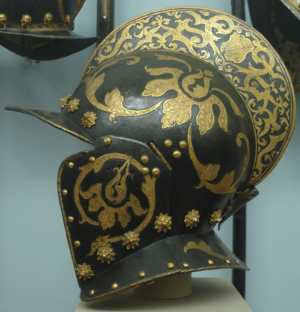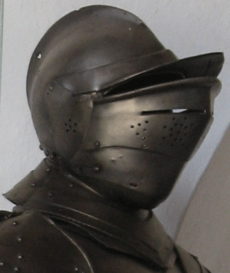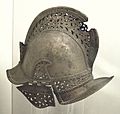Burgonet facts for kids
The burgonet helmet was a cool type of helmet used a long time ago, during the Renaissance (a period of great change in Europe) and early modern times. It was a popular helmet for soldiers, especially cavalry, and was an improved version of an older helmet called the sallet.
Contents
What Made the Burgonet Special?
The burgonet helmet had some unique features that made it stand out.
- Skull and Peak: The main part of the helmet, called the skull, usually had a large, strong peak that stuck out above the face. This peak could be fixed in place or hinged, meaning it could move.
- Crest: Many burgonets also had a raised ridge, like a keel on a boat, running from the front to the back of the helmet. This was called a crest or comb.
- Cheekpieces: Strong, hinged pieces of metal covered the sides of the face. These cheekpieces usually didn't meet under the chin.
- Neck Protection: A wide edge, called a flange, stuck out from the bottom of the helmet and cheekpieces. This helped protect the back and sides of the neck.
- Falling Buffe: Even though the burgonet usually had an open face, some versions had a special visor called a "falling buffe." This visor would slide up from the bottom to cover the face, instead of flipping down like most visors.
- Close Burgonets: Some burgonets were made to be more protective. These "close burgonets" combined features of the burgonet, like its peak and crest, with parts from a heavier helmet called a close helmet. This included a hinged chin guard called a bevor.
Who Used the Burgonet Helmet?
The burgonet helmet became very common all over Europe. It first appeared in the early 1500s and looked like its most famous version by about 1550.
- Cavalry: These helmets were mostly worn by cavalry (soldiers who fought on horseback). This included cuirassiers (heavy cavalry), demi-lancers (medium cavalry), and hussars (light cavalry).
- Border Reivers: People living near the border between England and Scotland, known as the Border Reivers, really liked burgonets. They often called themselves "steil bonnets," which means "steel helmets."
- Polish Hussars: The famous Polish winged hussars also used burgonets. Their helmets sometimes mixed features of the burgonet with other types of helmets, often including a metal bar or guard to protect the face.
- Swiss Soldiers: Mercenary Swiss infantry (foot soldiers), especially pikemen who used long spears, also commonly wore burgonets. They might have even taken these helmets from defeated cavalry as trophies.
Why Soldiers Liked the Burgonet
The burgonet helmet offered several advantages over older, heavier helmets:
- Lower Cost: Burgonets were much cheaper to make than full-face helmets. They had fewer hinges and locking parts, which saved money. This was a big reason why many soldiers chose to wear them.
- Easier to Wear: While other helmets could be heavy and make it hard to see or breathe during a fight, the burgonet was lighter. Its open face made it easier for soldiers to see and breathe, which was a big help in close combat.
- Good Protection: Even though it wasn't as heavy as some other helmets, the burgonet still protected most of the head very well. And if a soldier wanted more face protection, they could add a falling buffe.
Images for kids
-
A fancy parade burgonet that belonged to Henry II of France in the 1500s. It is now in the Army Museum (Paris).
-
A very decorated parade burgonet made by Filippo Negroli in 1543, now at the Metropolitan Museum of Art.
-
An ornate burgonet with cheek-guards from the Philippine Moros, from the 1700s or 1800s. It is in the Museo de América.







